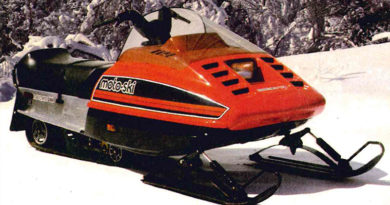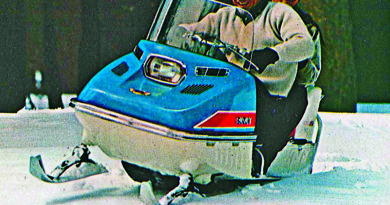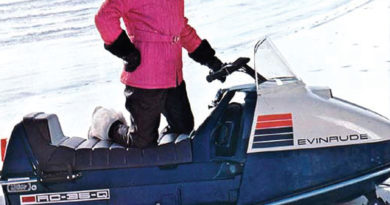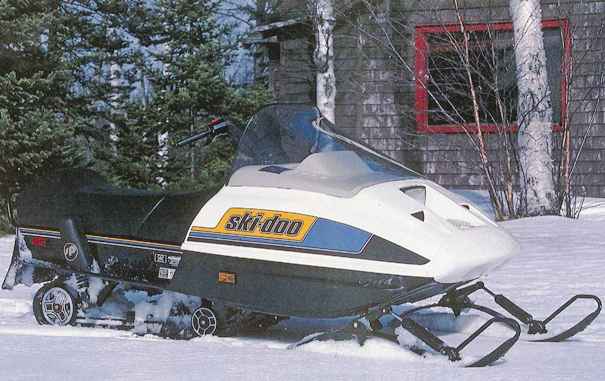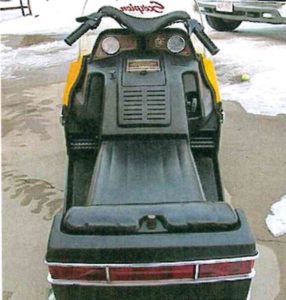
In 1977 Scorpion unveiled its new ’78 Whip TK premium trail sled, a machine about which many people are aware. But Scorpion’s first TK was actually the 1973 Super Stinger TK.
Back then, the TK designation was only a production code to differentiate Super Stinger 400s with JLO piston-port engines from Super Stinger 400 RVs with their CCW reed-valve engines.
But the big news was that the Super Stinger 400 TK was available not only in the company’s well-established metal flake red, but also in an eye-catching sunshine yellow at no additional charge. This egregious disregard of the industry’s well-established color code may have been due to the fact that the company’s president at the time was former Ski-Doo distribution executive Warren Daoust. The Super Stinger 440 was also available in an “immaculate white” as well as metal flake red.
These new hues were promoted with statements like, “Who else but Scorpion would be first with colors?” Actually they were nowhere near first, as about a dozen smaller brands including Viking, Swinger, Northway, Moto-Kometik and Ski-Zoom, had already offered color choices on their models, and several more including Ski-Doo, Arctic Cat and MTD Columbia broke the color code concurrently with Scorpion. But that didn’t matter because the screaming yellow hood did its job exceptionally well by focusing many people’s attention on Scorpion.
Evolution
The 1973 Scorpions really didn’t look different from the 1972 models that had been nearly all new from the ground up, many of which were still piled up as unsold inventory from the 20,000 units produced for 1972. But there were many subtle changes.
In a major safety upgrade, ankle-breaker tunnel stirrups were now history. JLO engines joined the CCWs that had powered all 1972 Scorpions, and a new version of the Power Thrust drive clutch was said to improve power delivery to the track by 20 percent. Polyurethane tracks replaced rubber ones, while the Para-Rail rear suspension rack was changed from steel to aluminum and received three more wheels on the internal cross shafts. Ski shock mounts were reworked, control upgrades improved operator comfort and more powerful headlamps met upgraded industry lighting standards.
Despite the aggressive sounding Super Stinger name, these sleds were anything but high-performance models. As Popular Snowmobiling magazine pointed out, “[Scorpion officials] never said they built a racing machine.” And they certainly hadn’t with the family oriented TK.
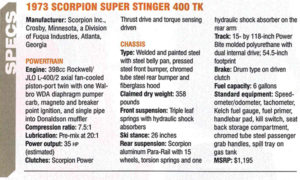
Popular Snowmobiling reviewers rated comfort as the high-point of the sled, commenting that “the rider (is) well protected,” and noting that the engine housing insulated riders from engine noise, but had large panels for effective access. However, reviewers did complain that the buckhorn handlebar was not shaped for maximum turning leverage, and handling was rated “slow and sluggish at lower speeds, but agile in lean and climbing tests.”
Reviewers also noted that in aggressive handling tests, “the machine wanted to roll outward at inopportune times” – common behavior of sleds with engines mounted on the tunnel. Other testers backed them up on this; “It goes over at 36 degrees,” reported Invitation to Snowmobiling magazine. “We didn’t test many tippier than that.” Popular Snowmobiling also tried jumping the TK and offered only one word of advice afterward: “Don’t!”
The final summation from Popular Snowmobiling was that the TK is “a good, reliable machine with a healthy engine that won’t take too much high performance antics. Keep it on the ground and it should be ready whenever you are for a long ride.”
Many buyers encountered reliability problems – notably ignition and clutching – with Scorpions from the early ’70s. Braking distance was still poor despite increased brake surface, as noted by Invitation to Snowmobiling. And the ParaRail was controversial to say the least. It worked well in low or no snow conditions, but did not deliver anywhere near the ride quality of a good slide rail system.
Encore & Exit
For 1974 – the last year of the company’s ownership by conglomerate Fuqua Industries – Scorpion did a modestly restyled version of these sleds as the swan song of the famous Stinger series, with the yellow replaced by gold metal flake. The 1975 model year brought the virtually all-new Whip series that propelled Scorpion into modern engineering and construction methods – a series that would culminate with the Whip TK and TK.X models a few years later.
The ’73 Super Stinger 400 TK was the first and only yellow Scorpion ever produced. It contributed very significantly to the destruction of the industry’s long held color code, and that makes it a historic sled for the entire sport, as well as a Scorpion fancier’s delight.
Editor’s Note: Every issue of Snow Goer magazine includes in-depth sled reports and comparisons, aftermarket gear and accessories reviews, riding destination articles, do-it-yourself repair information, snowmobile technology and more! Subscribe to Snow Goer now to receive issues delivered to your door 6 times per year for a low cost.

